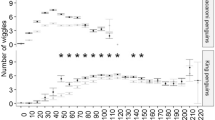Abstract
Diving and foraging behavior of Eurasian Coots (Fulica atra) have been scarcely studied in the Mediterranean area. In this pilot study, we compared the pecking rates and diving activities of this bird species in different habitat types of a small remnant wetland of central Italy. Mean pecking rate was 0.81 pecks/s. Feeding activity by pecking showed a significant difference between the selected habitat types with the highest pecking rate value in muddy soils with vegetation. The total-diving events were observed only in the deep water and not in shallow water, showing an average value of 5.27 s (±2.39). Mean time of the partial-diving events was 1.39 s (±0.75) with a maximum in rush beds with deep water, and a minimum rush beds with shallow water. We observed a prevalence of partial-diving events in the deep water habitat type.



Similar content being viewed by others
References
Arnold TW, Ankey JD (1997) The adaptative significance of nutrient reserves to breeding American Coots: a reassessment. Condor 99:91–103
Battisti C (ed) (2006) Biodiversità, gestione, conservazione di un’area umida del litorale tirrenico: la “Palude di Torre Flavia”. Gangemi editore—Provincia di Roma, Assessorato alle politiche agricole e dell’ambiente, Roma
Battisti C, Aglitti C, Sorace A, Trotta M (2006) Water level and its effect on the breeding bird community in a remnant wetland in Central Italy. Ekològia (Bratislava) 25:252–263
Batulis JC, Bongiorno SF (1972) Effect of water depth on diving times in the American Coot (Fulica americana). Auk 89:665–667
Bibby CJ, Burgess D, Hill DA (2000) Bird census techniques. Academic Press, London
Blasi C (1994) Fitoclimatologia del Lazio. Carta del Fitoclima del Lazio. Università degli studi di Roma “La Sapienza”, Roma. Regione Lazio
Brinkhof MWG (1997) Seasonal variation in food supply and breeding success in European Coot Fulica atra. Ardea 85:51–65
Capecchi P (2006) Geologia e Idrogeologia. In: Battisti C (ed) Biodiversità, gestione, conservazione di un’area umida del litorale tirrenico:la Palude di Torre Flavia. Gangemi editore—Provincia di Roma. Assessorato alle politiche agricole e dell’ambiente, Roma, pp 75–80
Cramp S, Simmons KEL (eds) (1980) The Birds of the Western Palearctic, vol 2. Oxford University Press, Oxford
Dow DD (1964) Diving times of wintering water birds. Auk 81:556–558
Fortunati L, Battisti C (2010) Diving times and feeding rate by pecking in Eurasian Coot (Fulica atra). Ethol Ecol Evol (in press)
Glutz von Blotzheim UN, Bauer KM, Bezzel E (1973) Handbuch der Vögel Mitteleuropas. Band 5. Akademische Verlagsgesellschaft, Frankfurt/Main
Hurter HU (1972) Nährung und Ernährungsweise des Blässhuhns Fulica atra am Sempachersee. Der Ornithol Beobachter 69:125–149
Irwin S, O’Halloran J (1997) The wintering behaviour of coot Fulica atra L. at Cork Lough, South-west Ireland. Biol Environ Proc Royal Ir Acad 97B:157–162
McKnight SK (1998) Effects of food abundance and environmental parameters on foraging behaviour of gadwalls and American Coots in winter. Can J Zool 76:1993–1998
McKnight SK, Hepp GR (1998) Foraging-Niche dynamics of gadwalls and American Coots in winter. Auk 115:670–683
Randler C (2004) Coot benefit from feeding in close proximity to Geese. Waterbirds 27:240–244
Randler C (2005) Coots Fulica atra reduce their vigilance under increased competition. Behav Process 68:173–178
Ryan MR, Dinsmore JJ (1979) A quantitative study of the behaviour of breeding American Coots. Auk 96:704–713
Sharrock JTR (1976) The atlas of breeding birds in Britain and Ireland. T and AD Poyser, London
Stewart PA (1967) Diving schedules of common loon and a group of old-squaws. Auk 84:122–123
Sutherland WJ (2006) Ecological census techniques. Cambridge University Press, Cambridge
Acknowledgments
This work has been carried out during a field work for a thesis in Biological Sciences (‘Roma Tre’ University). We thank Prof. Marco A. Bologna for the support and suggestions, and two anonymous referees for their useful critical comments on the submitted draft.
Author information
Authors and Affiliations
Corresponding author
Rights and permissions
About this article
Cite this article
Conigliaro, M., Battisti, C., Amori, G. et al. Diving times and pecking rates of the Eurasian Coot (Fulica atra) in different habitat types: a pilot study. Rend. Fis. Acc. Lincei 22, 47–53 (2011). https://doi.org/10.1007/s12210-010-0113-1
Received:
Accepted:
Published:
Issue Date:
DOI: https://doi.org/10.1007/s12210-010-0113-1




